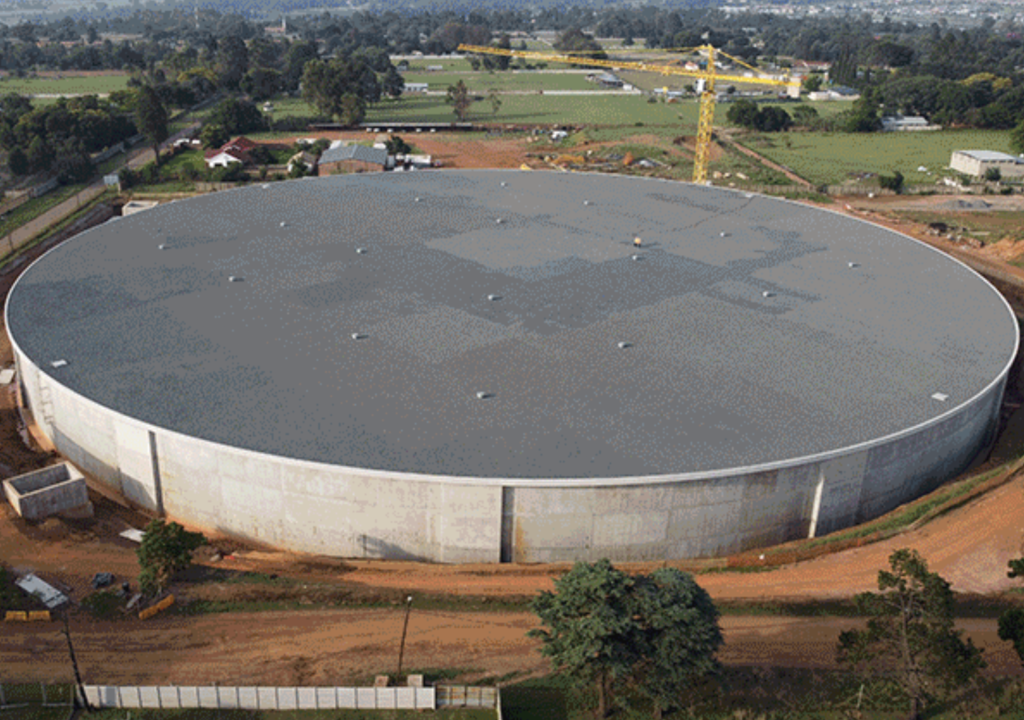
Rand Water has announced the opening of a new ‘mega reservoir’ in the Gauteng city of Ekurhuleni.
According to the utility, the freshly constructed 210 megalitre Vlakfontein Reservoir is South Africa’s largest cylindrical and circular reservoir, and one of the largest in the world.
The reservoir, at 210 megalitres, can contain enough water to fill 84 Olympic-size swimming pools, which average 2.5 megalitres.
Sipho Mosai, chief executive of Rand Water, told SAfm that the new construction is a technical wonder that would help provide water to regions impacted by shortages.
According to the executive, Gauteng’s water supply has been encountering ongoing issues due to rolling outages.
According to Mosai, the new reservoir would provide an additional 24-hour water buffer for communities hit by water shortages when pumps in the Tshwane or Pretoria area lack the requisite electricity.
He stated that the reservoir is the world’s largest post-tension reservoir at 210 megalitres, which is larger than the second largest in Saudi Arabia, which is 200 megalitres.
Post-tensioning is a process that applies tension to hardened concrete using steel cables, boosting its strength and longevity.
According to water and sanitation minister Senzo Mchunu, the reservoir’s size means it can contain enough water to last 24 hours if pumping problems arise.
The minister urged other provinces to implement similar mitigation initiatives and measures, saying that the department is collaborating with local governments to ensure that all regions are “looked after” and that water is accessible.
According to Rand Water, 13 additional reservoirs are planned or are now under development. According to the organisation, water may be load shifted between the various systems, which should help in times of crisis.
HKG Consulting, which was engaged in the project, noticed the following technical features of the construction:
The reservoir has a 154-metre inner diameter and an 11.8-metre wall height. The reservoir has a flat slab roof supported by 256 8.4-metre-spaced columns.
“Since the reservoir is 6 metres below natural ground level, both a leakage detection system and a ground water drainage system, separated by a reinforced flexible polypropylene liner, is provided underneath the complete footprint of the reservoir,” the group said.
The reservoir’s construction began in 2015, with an official completion date set for mid-2023.
“This is probably one of the largest cylindrical post-tensioned concrete reservoirs in the world,” it said.
Vandalism and load shedding
South Africa’s water system is under severe strain as a result of load shedding, bad weather, and a lack of sufficient maintenance.
Load shedding is currently the most serious of these challenges. Vandalism against essential energy infrastructure has had unprecedented consequences on water pumps in Gauteng, according to Mosai.
He stated that an upsurge in this sort of crime has lengthened the time it takes for water pumps to be restored since the municipality and Eskom must do evaluations before proceeding.
Mosai stated that in certain situations, stations were unable to pump for 12 hours due to vandalism. He also stated that it takes longer for pumps to restart since they are turned on in phases, lengthening the time it takes to return to full capacity.
In recent months, systems have also come under strain, notably in Gauteng, due to heat waves and lengthy spells of dry weather in the latter months of 2022.
Communities have been working with Rand Water to update infrastructure, which has resulted in lengthy times of interruption while maintenance is performed. In February, such a time is scheduled for the City of Tshwane.
The City of Tshwane has notified citizens that Rand Water would be closing down a crucial pipeline for repair later this month, resulting in no water delivery to specific regions for around 30 hours.
The closure is scheduled to complete the tie-ins of the newly constructed S4 water supply, which caused disruptions in Gauteng regions in 2022.
The work will begin at 03h00 on Friday, February 24, 2023, and will go until 09h00 on Saturday, February 25, 2023.